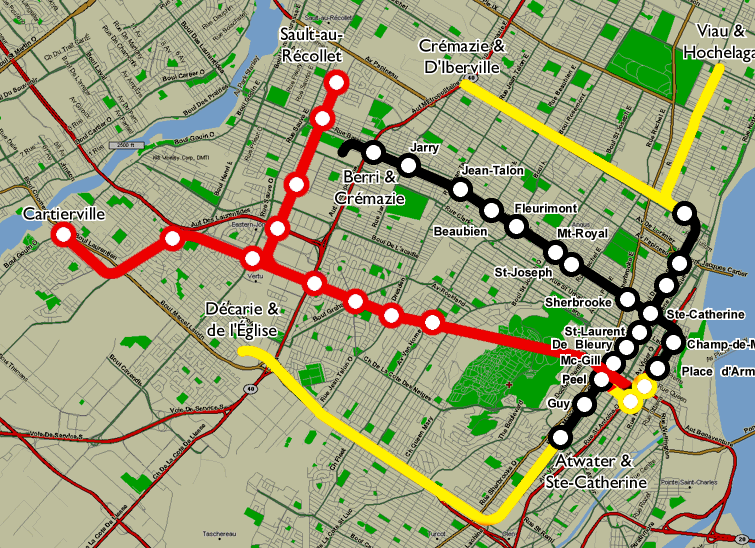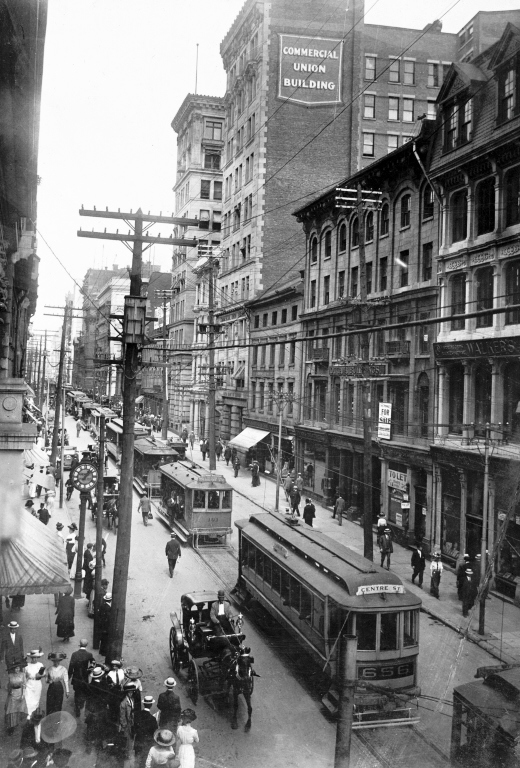|
Line 3 Red (Montreal Metro)
The Red Line (french: Ligne rouge), also known as Line 3 (french: Ligne 3), was a proposed line of the Montreal Metro that never made it past its planning stage. The line was supposed to have 15 stations and end at Cartierville (western) of Bordeaux-Cartierville, using Canadian National Railway, CN tracks and Mount Royal Tunnel under Mount Royal. The line was cancelled because: * Trains would have to use steel wheels instead of rubber tires like the rest of the Metro cars because part (or most) of the line was to go outside. * Expo 67 made the Line 4 Yellow (Montreal Metro), Yellow Line more important. The line was still planned for construction as a "regional metro" line in the early 1980s, reduced to a total of 9 stations. The tracks were used by the Commuter rail in North America, commuter rail Deux-Montagnes Line (AMT), Deux-Montagnes Line between 1995 and 2020, and will form the central section of the planned Réseau express métropolitain. 1982 list of planned stations The ... [...More Info...] [...Related Items...] OR: [Wikipedia] [Google] [Baidu] |
Réseau Express Métropolitain
The Réseau express métropolitain (REM; en, Metropolitan Express Network) is a light metro rapid transit system under construction in Greater Montreal, Quebec, Canada. When completed in 2025, the system will link several Montreal suburbs and Montréal–Trudeau International Airport with Downtown Montreal. The existing Deux-Montagnes line is being converted to light metro standards. The light metro rail system is projected to cost $6.9billion. It will be independent of—but connect to—the existing Montreal Metro, operated by the STM. Trains on the network will be fully automated and driverless, and it will become the fifth-longest automated transportation system in the world, after the Singapore Mass Rapid Transit, Kuala Lumpur Rapid KL, Vancouver SkyTrain, and Dubai Metro. The first section between Brossard and Central Station is expected to open in the second quarter of 2023. History On 13 January 2015, Quebec Premier Philippe Couillard and Michael Sabia, CEO of C ... [...More Info...] [...Related Items...] OR: [Wikipedia] [Google] [Baidu] |
Line 7 White (Montreal Metro)
The White Line (french: Ligne blanche), also known as Line 7 (french: Ligne 7), was a proposed line of the Montreal Metro that never made it past its planning stage. The White Line was first proposed by the Commission de transport de Montréal (CTM) during the initial planning for the Montreal Metro in 1953, and in 1970 the Communauté urbaine de Montréal (CUM) proposed an extension of the Green Line to Montréal-Nord. In September 1983, the Bureau des Transports de Montréal (BTM) proposed a new north-south Line 7 consisting of ten stations, from Pie-IX to Léger, under Boulevard Pie-IX, through Saint-Léonard and north-east towards Rivière-des-Prairies. A year later, at the start of 1984, it was formally proposed by the Communauté urbaine de Montréal (CUM), with 12 stations (from Pie-IX to Maurice-Duplessis/Langelier). For nearly a decade during the 1980s and 1990s, the line appeared on all official Métro maps, coloured white, so it received the unofficial nickname of ... [...More Info...] [...Related Items...] OR: [Wikipedia] [Google] [Baidu] |
Line 6 (Montreal Metro)
Line 6 was a proposed surface-running line of the Montreal Metro. Unlike the rubber-tire technology used on the Metro's current lines, Line 6's trains would have run on steel wheels. Planned as the first of a series of new "regional metro" lines along existing railways in 1979 (similar in concept to the Paris RER and San Francisco BART), the Ministère de Transport du Québec (MTQ) expected Line 6 to begin service along 23.3 km of Canadian National railway tracks by 1989. According to a MTQ proposal from 1982, Line 6 would have intersected the Orange Line (Line 2) at Du College and Sauve stations, and along with a planned transfer with the also-unbuilt Red Line, or Line 3, the line would have had 11 stations overall. Running along the northern part of the island, it would have passed through the districts of St. Laurent, Ahuntsic, Saint-Michel, Montreal-Nord, Riviere-des-Prairies and Pointe-aux-Trembles."Le Métro fait surface: La ligne 6". Quebec Science, vol. 21, no. 3, No ... [...More Info...] [...Related Items...] OR: [Wikipedia] [Google] [Baidu] |
Deux-Montagnes (AMT)
Deux-Montagnes is a future terminus station of the Réseau express métropolitain (REM) in Deux-Montagnes, Quebec, Canada. REM service at the station is scheduled to begin in the fourth quarter of 2024. The station will serve as the terminus of the Deux-Montagnes branch of the REM. Until the end of 2020, Deux-Montagnes was a commuter rail station operated by Exo and was the northern terminus of the Deux-Montagnes line. Origin of name Deux-Montagnes takes its name from Deux-Montagnes, the municipality where it is located, although this station took the name of the original Gare Deux-Montagnes, now Grand-Moulin station. The building serves as municipal offices, as well as a passenger waiting area for the connecting routes. Outside of the building, is the former CN 6710, a GE boxcab electric-powered locomotive that brought trains through the Mount Royal Tunnel until 1995. Location The station is located at 400, boul. Deux-Montagnes, near Autoroute 640 (exit 8). The station i ... [...More Info...] [...Related Items...] OR: [Wikipedia] [Google] [Baidu] |
Bois-Franc (AMT)
Bois-Franc is a future Réseau express métropolitain (REM) interchange station in the Bois-Franc neighbourhood of Montreal, Quebec, Canada. REM service is expected to begin at the station in the fourth quarter of 2024. It was formerly commuter rail station on the Deux-Montagnes line until Exo ended service in 2020. Origin of name Bois-Franc takes its name from the nearby Bois-Franc residential development, itself named for ''chemin du Bois-Franc'', the original name of the stretch of boulevard Henri-Bourassa through this area, which had previously ended at the Laurentian Autoroute. Bois Franc was also the original name of the nearby pioneer airstrip that later was known as Cartierville Airport, until its closing in the 1980s. History The original station was named Lazard (likely for the Franco-American merchant bank Lazard Frères & Co. which underwrote the construction of the Mount Royal Tunnel on this rail line). In 1926, the station was renamed Val-Royal. After the mod ... [...More Info...] [...Related Items...] OR: [Wikipedia] [Google] [Baidu] |
Mont-Royal (AMT)
Ville-de-Mont-Royal station is a future Réseau express métropolitain (REM) station, expected to open in 2024. It is located in Mont Royal, Quebec, about northwest of Canora station. Until May 2020, this station was named Mont-Royal and was a commuter rail station operated by Exo. It was served by the Deux-Montagnes and Mascouche lines until its closure in 2020. Origin of name Mont-Royal takes its name from Town of Mount Royal (in French, Ville-Mont-Royal), where the station is located; the town in turn, takes its name from Mount Royal, the mountain that dominates the Island of Montreal. In the city of Montreal, there is also an unrelated Metro station of the same name. Location The station is located at the eastern end of the traffic circle created by Graham and Laird boulevards, between and between Lombard Crescent and Dunkirk road. Connaught Park is inside this traffic circle History Mont-Royal station was until 1992 a stop for Via Rail passenger trains leavi ... [...More Info...] [...Related Items...] OR: [Wikipedia] [Google] [Baidu] |
Gare Centrale (Montreal)
Montreal Central Station (french: Gare centrale de Montréal) is the major inter-city rail station and a major commuter rail hub in Montreal, Quebec, Canada. Nearly 11 million rail passengers use the station every year, making it the second-busiest train station in Canada, after Toronto Union Station. The main concourse occupies almost the entire block bounded by De la Gauchetière Street, Robert-Bourassa Boulevard, René Lévesque Boulevard and Mansfield Street in downtown Montreal. Its street address and principal vehicular access are on de La Gauchetière; pedestrian access is assured by numerous links through neighbouring buildings. The station is adorned with art deco bas-relief friezes on its interior and exterior. The station building and associated properties are owned by Cominar REIT as of January 2012. Homburg Invest Inc. (renamed Canmarc in September 2011) was the previous owner, since November 30, 2007. Prior to that, from the station's inception in 1943, it had ... [...More Info...] [...Related Items...] OR: [Wikipedia] [Google] [Baidu] |
Deux-Montagnes Line (AMT)
Deux-Montagnes or Two Mountains Line (also designated exo6 and formerly Red Line) was formerly a commuter railway line in Greater Montreal, Quebec, Canada. It was owned by Exo, the organization that operates public transport services across this region. The line was created in 1918 as a Canadian Northern Railway (CNoR) service. Canadian National Railway (CN) ran the line starting in 1923 following the merger of CNoR into CN. CN transferred the Deux-Montagnes Line to the Société de transport de la communauté urbaine de Montréal (STCUM) on July 1, 1982. The line was refurbished from 1992 to 1995. It was transferred to the RTM's predecessor agency, the Agence Métropolitaine de transport (AMT) on January 1, 1996. The RTM assumed current operation of the line upon its establishment on June 1, 2017. The RTM rebranded its commuter services "exo" in 2018. On May 11, 2020, service between and Montreal Central Station was closed due to the construction of Réseau express métropo ... [...More Info...] [...Related Items...] OR: [Wikipedia] [Google] [Baidu] |
Montreal Metro
The Montreal Metro (french: Métro de Montréal) is a rubber-tired underground rapid transit system serving Greater Montreal, Quebec, Canada. The metro, operated by the Société de transport de Montréal (STM), was inaugurated on October 14, 1966, during the tenure of Mayor Jean Drapeau. It has expanded since its opening from 22 stations on two lines to 68 stations on four lines totalling in length, serving the north, east and centre of the Island of Montreal with connections to Longueuil, via the Yellow Line, and Laval, via the Orange Line. The Montreal Metro is Canada's second busiest rapid transit system and North America's fourth busiest rapid transit system, behind the New York City Subway, the Mexico City Metro and the Toronto subway, delivering an average of daily unlinked passenger trips per weekday as of . In , trips on the Metro were completed. According to the STM, the Metro system had transported over 7 billion passengers as of 2010. With the Metro and t ... [...More Info...] [...Related Items...] OR: [Wikipedia] [Google] [Baidu] |




